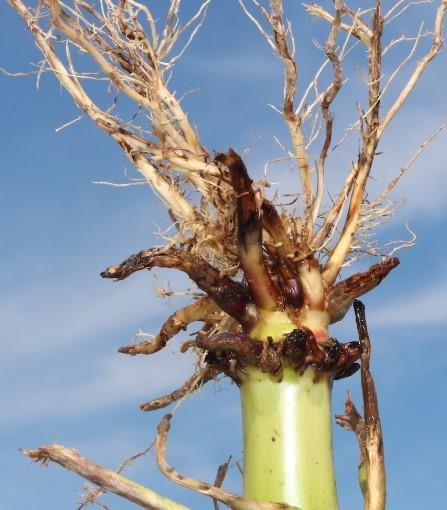By Bryan Jensen
No calls or emails have been received regarding lodged corn from rootworm feeding but I suspect they will be coming soon. Let’s take a couple minutes to prepare just in case.
This is the time of year when larval feeding is peaking as is corn height. Throw in some heavy rains, high winds and you will likely see some corn lodged. Don’t assume this lodging is a result of rootworm feeding. Don’t assume that it isn’t.
To determine if rootworm feeding was a possible cause, dig and power wash roots from several areas of each field. While you are at it, dig roots from healthy looking corn fields as well. I would suggest using a power washer to remove all soil. Although severe root pruning may really stand out, subtle damage that may indicate poor performance of your rootworm management practice may not. If soil is not completely removed, you could overlook damage.
Healthy corn roots are white, and these roots will extend far beyond what you are able to dig with a spade. Knowing the difference between rootworm feeding and “shovel blight” will be helpful. Roots injured by a shovel will remain relatively healthy looking and white but are ikely to be a little frayed by the shovel. Roots pruned by rootworms will be discolored at the tips and that discoloration may extend back on the root. Rootworms may also “scar” individual roots and this injury will look brownish. Washing roots soon after digging will help distinguish rootworm injury from shovel blight.
The Iowa State Nodal Injury Scale (NIS), developed by Iowa State Entomologists, is the industry standard for quantifying root damage and this rating scale focuses on root pruning cause by late instar larvae. Briefly, the number to the left of the decimal is the number (or equivalent number) of root nodes pruned to within in 1 ½ inches of the stalk. The number to the right of the decimal equals the percentage of the next node of roots pruned. Therefore, a rating of 1.5 indicates the equivalent of 1 full root node pruned and 50% of the next. (See image) I do like the idea of taking the time to rate damage as it gives you some perspective from year to year and avoids people trying to translate what a lot or a little really is.
Late-July, early-August is usually the best time to evaluate the presence or absence of rootworm damage. If we wait until late-August, there may be significant regeneration of roots which can mask feeding. August root evaluations are still possible just more difficult.

Source : wisc.edu